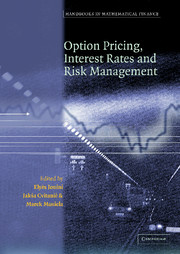Book contents
- Frontmatter
- Contents
- List of Contributors
- Introduction
- Part one Option Pricing: Theory and Practice
- 1 Arbitrage Theory
- 2 Market Models with Frictions: Arbitrage and Pricing Issues
- 3 American Options: Symmetry Properties
- 4 Purely Discontinuous Asset Price Processes
- 5 Latent Variable Models for Stochastic Discount Factors
- 6 Monte Carlo Methods for Security Pricing
- Part two Interest Rate Modeling
- Part three Risk Management and Hedging
- Part four Utility Maximization
4 - Purely Discontinuous Asset Price Processes
from Part one - Option Pricing: Theory and Practice
Published online by Cambridge University Press: 29 January 2010
- Frontmatter
- Contents
- List of Contributors
- Introduction
- Part one Option Pricing: Theory and Practice
- 1 Arbitrage Theory
- 2 Market Models with Frictions: Arbitrage and Pricing Issues
- 3 American Options: Symmetry Properties
- 4 Purely Discontinuous Asset Price Processes
- 5 Latent Variable Models for Stochastic Discount Factors
- 6 Monte Carlo Methods for Security Pricing
- Part two Interest Rate Modeling
- Part three Risk Management and Hedging
- Part four Utility Maximization
Summary
Introduction
Prices of assets determined in highly liquid financial markets are generally viewed as continuous functions of time. This is true of the Black–Scholes (1973), and Merton (1973) model of geometric Brownian motion for the dynamics of the price of a stock, and of its many successors that include the stochastic volatility models of Hull and White (1987), Heston (1993) and the more recent advances into modeling the evolution of the local volatility surface by Derman and Kani (1994), and Dupire (1994). Jumps or discontinuities, when considered, have been added on as an additional orthogonal compound Poisson process also impacting the stock, as for example in Press (1967), Merton (1976), Cox and Ross (1976), Naik and Lee (1990), Bates (1996), and Bakshi and Chen (1997). This class of models is broadly referred to as jump-diffusion models and as the name suggests they are mixture models studying the high activity and low activity events by using two orthogonal modeling strategies.
The purpose of this chapter is to present the case for an alternative approach that stands in sharp contrast to the above mentioned models and synthesizes the study of high and low activity price movements using a class of purely discontinuous price processes. The contrast with the above class of models is that the processes advocated here have no continuous component, as all jump-diffusions must have, and furthermore, the discontinuities are infinite in number with moves of larger sizes coming at a slower rate than moves of smaller sizes.
- Type
- Chapter
- Information
- Handbooks in Mathematical FinanceOption Pricing, Interest Rates and Risk Management, pp. 105 - 153Publisher: Cambridge University PressPrint publication year: 2001
- 11
- Cited by



